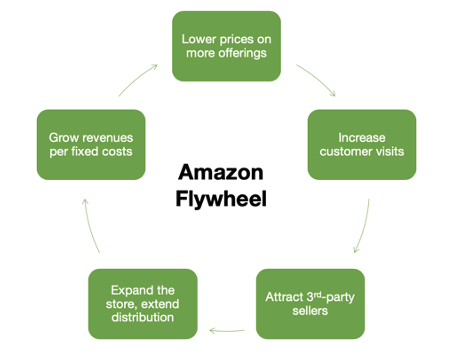Is it time to look at your strategy and think about how to compete and win in this new age of real estate?
In his iconic business strategy book, Good to Great, Jim Collins shares what he calls the “flywheel effect” — a transformational phenomenon that he observed in some of the world’s most successful companies.
It’s not about a single big idea or innovation, nor one groundbreaking marketing campaign or lucky moment. Instead, it’s a gradual, focused progression — much like pushing a massive flywheel forward, turn by turn, accelerating momentum until it reaches a breakthrough point.
The key to understanding your company’s flywheel (or as an individual agent) is to identify your four to six key business drivers and map how they work in a continuous cycle, influencing every decision, and building momentum based on each success.
Amazon provides the perfect flywheel example. Collins worked with Jeff Bezos, Amazon’s founder, in the months prior to the publication of Good to Great. He outlined their cycle like this: lower prices and more offerings lead to increased customer visits. More customers lead to increased sales which attracts even more third-party sellers. Then, this added income stream allows Amazon to innovate and boost efficiencies through more fulfillment centers and technology. Thus, they can grow their revenues per fixed costs. And this allows them to offer even lower prices and more products and the cycle begins again.

What powers your flywheel? What are the key drivers that propel your real estate business? Collins suggests a five-step process for defining it.
- Create a list of replicable successes your business has achieved.
- Compile a list of failures and disappointments, including new initiatives that fell flat or performed far below expectations.
- Compare the successes and failures and consider what they tell you about possible components.
- Using the 4-6 identified components, sketch the flywheel. Where does it start? What comes next? How does it circle back to the beginning?
- Test the flywheel against your list of successes and failures. Tweak until you can explain your biggest replicable successes as an outcome directly arising from your flywheel. Similarly, look at your failures and determine what elements of the flywheel were missing.
Once you get the flywheel right, then keep asking the question, “What can we do better to accelerate momentum?” You know you’re there when you say, “We almost can’t help what’s happening!” The right agents, buyers and sellers will keep coming, and you’ll have discovered your unbeatable strategy.
Jim Collins’ final advice is “when you reach 100 turns on a flywheel, go for a 1,000 turns, then 10,000 , then 1 million, then 10 million, and keep going. Apply your creativity and discipline to each and every turn with as much intensity as when you cranked out your first turns on the flywheel, nonstop, relentlessly, ever building momentum.”



